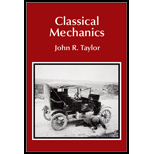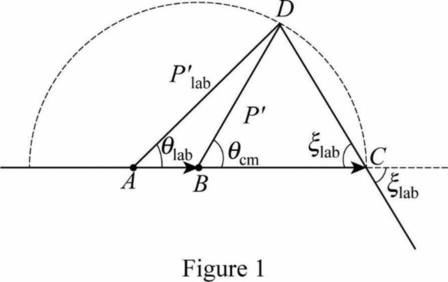
(a)
Prove that ξlab=(π−θcm)2
(a)
Answer to Problem 14.28P
The angle is ξlab=(π−θcm)2.
Explanation of Solution

Consider particle 1 with initial momentum plab 1 and particle 2 with zero initial momentum. Final momentum of particle 1 is p'lab 1 and final momentum of the particle 2 is p'lab 2.
According to law of conservation of momentum
plab 1+0=p'lab 1+p'lab 2p'lab 2=plab 1−p'lab 1
From the figure, AC denotes plab 1, AD represents p'lab 1 and p'lab 2 is represented by AC−AD
From the triangular law of vectors, AC−AD=DC
BD and BC is the radius of the circle. Thus the angles opposite to these sides are equal.
From the triangle ΔBCD,
∠BCD=∠BDC=ξlab
And,
∠DBC=θcm
The sum of all three angles of the triangle is equal to π rad.
Therefore for ΔBCD
ξlab+ξlab+θcm=π2ξlab+θcm=πξlab=π−θcm2
Conclusion:
The angle is ξlab=(π−θcm)2.
(b)
Show that in the case of equal masses, the angle of these outgoing particles in elastic collision is 90°.
(b)
Answer to Problem 14.28P
For the collision of equal masses, ξlab+θlab=π2
Explanation of Solution
Write down the expression connecting θlab and θcm
tanθlab=sinθcmλ+cosθcm
λ=1 for m1=m2.
Then,
tanθlab=sinθcm1+cosθcm=2sinθcm2cosθcm22cos2θcm2=tanθcm2
That is,
θlab=θcm2θcm=2θlab
Substitute π−2ξlab for θcm
ξlab=π−θcm2ξlab=π2−θlabπ2=ξlab+θlab
Hence proved.
Conclusion:
For the collision of equal masses, ξlab+θlab=π2
(c)
Prove ξlab+θlab=π2 using law of conservation of momentum.
(c)
Answer to Problem 14.28P
The expression ξlab+θlab=π2 has been proven using the law of conservation of momentum.
Explanation of Solution
Apply law of conservation of momentum in horizontal direction
plab1=p'lab1cosθlab+p'lab2cosξlab
Along vertical direction,
0=p'lab1sinθlab−p'labsinξlabp'lab1sinθlab=−p'lab2sinξlab
Apply the law of conservation of energy
p2lab12m1=p'2lab12m1+p'2lab22m2
Substitute m1=m2,
p2lab1=p'2lab1+p'2lab2
Then,
p'2lab1+p'2lab2=(p'lab1cosθlab+p'lab2cosξlab)2p'2lab1+p'2lab2=p'2lab1cos2θlab+p'2lab2cos2ξlab+2p'lab1cosθlabp'lab2cosξlab0=p'2lab1(1−cos2θlab)+p'2lab2(1−cos2ξlab)−2p'lab1p'lab2cosθlabcosξlab0=p'2lab1sin2θlab+p'2lab2sin2cos2ξlab−p'lab1p'lab2cosθlabcosξlab
On further simplification,
p'2lab1sin2θlab+p'2lab2sin2cos2ξlab=p'lab1p'lab2cosθlabcosξlab(p'2lab1sin2θlab+p'2lab2sin2cos2ξlab)2=2p'lab1p'lab2(cosξlabcosθlab+cosξlabcosθlab)(p'2lab1sin2θlab−p'2lab2sin2cos2ξlab)2=2p'lab1p'lab2(cosξlabcosθlab+cosξlabcosθlab)0=2p'lab1p'lab2(cosξlab+cosθlab)
Here 2p'lab1p'lab2≠0. Therefore cosξlab+cosθlab=0
Take cosine inverse on both sides
ξlab+θlab=cos−10=π2
Conclusion:
The expression ξlab+θlab=π2 has been proven using the law of conservation of momentum.
Want to see more full solutions like this?
Chapter 14 Solutions
Classical Mechanics
- A particle with a charge of − 5.20 nC is moving in a uniform magnetic field of (B→=−( 1.22 T )k^. The magnetic force on the particle is measured to be(F→=−( 3.50×10−7 N )i^+( 7.60×10−7 N )j^. Calculate the scalar product v→F→. Work the problem out symbolically first, then plug in numbers after you've simplified the symbolic expression.arrow_forwardNeed help wity equilibrium qestionarrow_forwardneed answer asap please thanks youarrow_forward
- A man slides two boxes up a slope. The two boxes A and B have a mass of 75 kg and 50 kg, respectively. (a) Draw the free body diagram (FBD) of the two crates. (b) Determine the tension in the cable that the man must exert to cause imminent movement from rest of the two boxes. Static friction coefficient USA = 0.25 HSB = 0.35 Kinetic friction coefficient HkA = 0.20 HkB = 0.25 M₁ = 75 kg MB = 50 kg P 35° Figure 3 B 200arrow_forwardA golf ball is struck with a velocity of 20 m/s at point A as shown below (Figure 4). (a) Determine the distance "d" and the time of flight from A to B; (b) Determine the magnitude and the direction of the speed at which the ball strikes the ground at B. 10° V₁ = 20m/s 35º Figure 4 d Barrow_forwardThe rectangular loop of wire shown in the figure (Figure 1) has a mass of 0.18 g per centimeter of length and is pivoted about side ab on a frictionless axis. The current in the wire is 8.5 A in the direction shown. Find the magnitude of the magnetic field parallel to the y-axis that will cause the loop to swing up until its plane makes an angle of 30.0 ∘ with the yz-plane. Find the direction of the magnetic field parallel to the y-axis that will cause the loop to swing up until its plane makes an angle of 30.0 ∘ with the yz-plane.arrow_forward
- A particle with a charge of − 5.20 nC is moving in a uniform magnetic field of (B→=−( 1.22 T )k^. The magnetic force on the particle is measured to be (F→=−( 3.50×10−7 N )i^+( 7.60×10−7 N )j^. Calculate the y and z component of the velocity of the particle.arrow_forwardneed answer asap please thank youarrow_forward3. a. Determine the potential difference between points A and B. b. Why does point A have a higher potential energy? Q = +1.0 C 3.2 cm 4.8 cm Aarrow_forward
 College PhysicsPhysicsISBN:9781305952300Author:Raymond A. Serway, Chris VuillePublisher:Cengage Learning
College PhysicsPhysicsISBN:9781305952300Author:Raymond A. Serway, Chris VuillePublisher:Cengage Learning University Physics (14th Edition)PhysicsISBN:9780133969290Author:Hugh D. Young, Roger A. FreedmanPublisher:PEARSON
University Physics (14th Edition)PhysicsISBN:9780133969290Author:Hugh D. Young, Roger A. FreedmanPublisher:PEARSON Introduction To Quantum MechanicsPhysicsISBN:9781107189638Author:Griffiths, David J., Schroeter, Darrell F.Publisher:Cambridge University Press
Introduction To Quantum MechanicsPhysicsISBN:9781107189638Author:Griffiths, David J., Schroeter, Darrell F.Publisher:Cambridge University Press Physics for Scientists and EngineersPhysicsISBN:9781337553278Author:Raymond A. Serway, John W. JewettPublisher:Cengage Learning
Physics for Scientists and EngineersPhysicsISBN:9781337553278Author:Raymond A. Serway, John W. JewettPublisher:Cengage Learning Lecture- Tutorials for Introductory AstronomyPhysicsISBN:9780321820464Author:Edward E. Prather, Tim P. Slater, Jeff P. Adams, Gina BrissendenPublisher:Addison-Wesley
Lecture- Tutorials for Introductory AstronomyPhysicsISBN:9780321820464Author:Edward E. Prather, Tim P. Slater, Jeff P. Adams, Gina BrissendenPublisher:Addison-Wesley College Physics: A Strategic Approach (4th Editio...PhysicsISBN:9780134609034Author:Randall D. Knight (Professor Emeritus), Brian Jones, Stuart FieldPublisher:PEARSON
College Physics: A Strategic Approach (4th Editio...PhysicsISBN:9780134609034Author:Randall D. Knight (Professor Emeritus), Brian Jones, Stuart FieldPublisher:PEARSON





